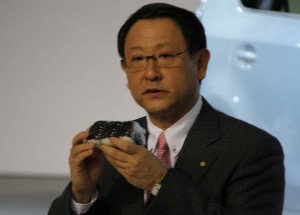
CEO Akio Toyoda says Toyota faces serious headwinds even after recovering from Japan's March disaster.
Toyota Motor Co. pointed its corporate finger at the March 11 Japanese earthquake and tsunami for the 99% decline in its earnings for the first-quarter of its latest fiscal year – but longer-term concerns about the strong yen pose problems that could extend well into the future, the automaker warned.
The maker raised a previously bleak earnings forecast for the full 2012 fiscal year, but the increase still fell below the general consensus of industry analysts who have been observing the maker’s ongoing recovery from the March disaster, which cost Toyota 599,000 units of last production for the April – June quarter.
“In Japan and North America where the effects of the earthquake were particularly serious, vehicle sales declined substantially,” noted TMC Senior Managing Officer Takahiko Ijichi.
For the quarter ending June 30, Toyota’s net income plunged to just 1.1 billion yen, or $14 million, down from 190 billion yen, or $2.5 billion, a year earlier. Sales and revenues fell by 30%, to 3.44 billion yen, or $44.5 million.
Compared to the first quarter of the previous year, unit sales were down by a third, to 1.22 million vehicles, knocking Toyota off its pedestal as the world’s largest automaker. The maker did manage to maintain sales volumes, Ijichi noted, in a few key Asian markets, such as Indonesia.
But the bulk of its Japanese operations were effectively shuttered for the first month after the quake due to parts shortages at key suppliers. North American plants were down by as much as two-thirds of their capacity through the beginning of summer and are still operating at reduced rates on four of eight product lines produced in the U.S. and Canada, including the Tacoma and Tundra pickups, noted Bob Carter, Group Vice President of Toyota Motor Sales, USA.
Toyota officials have said that they intend to make up as much capacity as possible during the remaining months of the fiscal year, and despite some ongoing problems, it appears key suppliers – such as microchip maker Renasas – are coming back on line more quickly than expected.
As a result, the maker said it now expects to produce 7.6 million vehicles through March 31, 2012, an increase of 360,000 compared to a forecast the maker issued in June – and still ahead of the 7.31 million vehicles Toyota produced last year.
The automaker now expects annual revenues to come in at 19 trillion yen, on a par with last year. But net income will likely drop, it cautioned, by about 4%, to 390 billion yen.
The drop reflects costs associated with recovering from the disaster, as well as higher raw materials costs, but the maker noted it is also facing a significant negative shift in exchange rates. The dollar has continued to defy expectations and continues to lose ground – though it remains to be seen if the budget compromise approved by Congress will help stabilize the U.S. currency. Toyota is especially vulnerable to shifts in the exchange rate because it still has a larger production base in Japan than any of its competitors.
During a June news conference, CEO Akio Toyoda acknowledged that maintaining such a large assembly network in quake-prone Japan was something the maker would have to reconsider, but he more recently indicated that no significant shift off the home islands was in the works.
“I think that in some ways, our history has been defined by a constant battle against currency swings and it’s made us stronger,” said Ijichi, during a Japanese news conference today.
Just days before the March disaster, CEO Toyoda announced a sweeping global strategy that, among other things, called for a 30% reduction in costs. But considering the sharp downturn in the dollar, even that might not be enough, conceded Ijichi, adding, “the speed of the yen’s rise is way beyond the limit.”
Complicating matters further, Toyota is facing some aggressive new competitors, notably including the fast-growing Korean marques Hyundai and Kia, as well as resurgent U.S. manufacturers.
The coming year will be a critical test for Toyoda’s new strategy and much will rest on the aggressive product launch program that will kick off with a new version of the popular Toyota Camry. But the decline of the dollar since the beginning of the year, Ijichi revealed, is costing Toyota about $3,000 in lost profits on a $20,000 vehicle.
Initial response to the Toyota earnings report saw a modest drop in the maker’s stock in Asian trading.
Toyota’s Japanese competitors have also felt the March 11 disaster’s impact. Honda this week reported a 90% drop in earnings, though Mitsubishi actually saw a jump in its first-quarter profit. (For more, Click Here.) Nissan, which has transferred a significant share of its production overseas, meanwhile, experienced a modest 10% year-over-year decline. (Click Here for more on Nissan.)
